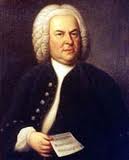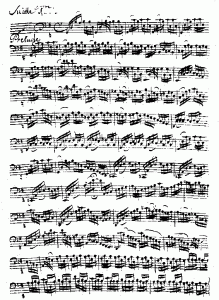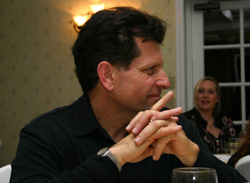God Glimmer
Tucson: Sunday , February 27, 2011 @ 3p.m. -
Scottsdale: Sunday, March 13, 2011 @ 3p.m.
world premiere
a brief description
” I did not know of their existence, and no one had ever mentioned them to me. It was the great revelation of my life. I immediately felt that this was something of exceptional importance, and hugged my treasure all the way home. I started playing them in a state of indescribable excitement. For twelve years I studied and worked at them every day, and I was nearly 25 before I had the courage to play one of them in public. Before I did, no violinist or cellist had ever played a Suite in its entirety. In those days these compositions were thought of as cold and academic. How could anyone think of Bach as ‘cold’, when these Suites seem to shine with the most glittering kind of poetry?”
Pablo Casals on his discovery of the Bach Suites, age 13
“I believe in God when I work.” Henri Matisse

J.S. Bach
How is it possible that J. S. Bach’s Six Suites for Unaccompanied Cello have not only become a mainstay of modern cellist’s repertoire, but have achieved a near universal appeal?
A bit of history first.
Bach’s understanding of the cello was a synthesis of thousands of experiences: hearing it played, seeing it in action, using it himself as a composer.Bach knew it first as a bass instrument, a basso continuo, supporting other more interesting voices, yet between 1717-1723 the cello became the beneficiary of six magnificent gifts. How so?
Prince Leopold, Bach’s employer in Cothen, Germany, was not much interested in church music and during these six years Bach composed much of his secular music including the Six Solo Violin Sonatas, The Brandenburg Concerti, and much else. As Kapellmeister at Cothen, serving Prince Leopold, Bach had an exceptional cellist Christian Bernhard Linike in his retinue.
Linike must of possessed exceptional technique and the six suites were an exploration of all the cello could muster technically, sonically, and musically. We must remember that the cello was the ‘new kid on the block, the viola da gamba being its predecessor. Bach, always reverent of the past, clung to the gamba and composed for it till the end of his life.
And we must keep in mind that the Cello Suites were composed ‘off the clock’, as there is no mention of any public performance of them during Bach’s stay in Cothen. The realization of these works were Bach’s extraordinary curiosity about the cello and their muse, Herr Linike, certainly one of the great unsung heroes of cello history.
The most striking thing about the Suites is that they are unaccompanied!
Suites are both top voice and continuo, melody and harmony.Each suite strives towards greater virtuosity and deeper musicality but the simplicity of the Suite #1 in G has as much appeal as the complicated, dark-hued fugue Suite #5 in C minor.
Each Suite has its own character. Bach’s genius was not to burden the cello with excessive chordal writing to show harmony, but instead implies harmony with deft touches thereby keeping the dance-like qualities of the Suites ever forefront.
The Suites are an amalgam of popular French, Spanish, and of course German dances of the time. Bach intended for these pieces to show the new found instrument in all its many capacities.
Audiences and cellists certainly took their time to find their beauty. It is well known that by the time of Bach’s death he was better known as an organist than composer. The second half of the 18th century saw the disappearance of the suite, the sonata becomes the great compositional form.. For nearly the whole of the 19th century the Suites went un-played except as dry etudes in German Hochschules.
It took the great Spaniard, Pablo Casals, the George Washington of the Suites to recognize their value. The story of his discovery is as much a part of the cello legend as Washington’s cherry tree. Casals was thirteen, studying in Barcelona, and always in search of new music to play at Senor Tost’s café. Casals played popular music several times a week but one evening was set aside for classical music.Casal’s father had brought with him a full size cello and together they rummaged through second hand shops near the harbor in search of music.It was in one stall that he stumbled across the Beethoven sonatas and then, to his amazement, on a dusty shelf Six Suites for cello solo by Bach.
Casals said of this great find: ‘I did not know of their existence, and no one had ever mentioned them to me. It was the great revelation of my life. I immediately felt that this was something of exceptional importance, and hugged my treasure all the way home. I started playing them in a state of indescribable excitement. For twelve years I studied and worked at them every day, and I was nearly 25 before I had the courage to play one of them in public. Before I did, no violinist or cellist had ever played a Suite in its entirety. In those days these compositions were thought of as cold and academic. How could anyone think of Bach as ‘cold’, when these Suites seem to shine with the most glittering kind of poetry?’It took another 35 years before he would consent to record them in the 1930s. They had only been around 200 years at this point.
It’s now 2010 and at last count there are over 150 complete recordings of the Suites; violists, trombonists, guitarists, getting into the act as well. Probably 100 printed editions of the Suites, non ever made or sanctioned by Casals himself, but nearly every one else has gotten into the act.
One final detail. There exists no copy of the Suites in Bach’s own handwriting. The closest we have is a fair copy made by Anna Magdalena, Bach’s beloved second wife.
About the music
The entire program includes diverse movement form all of the six suites for solo cello.
Audio clip: Adobe Flash Player (version 9 or above) is required to play this audio clip. Download the latest version here. You also need to have JavaScript enabled in your browser.
Prelude of the First Cello Suite, performed by guitarist Kazuhito Yamashita
Performers
This performance marks Harry Clark’s debut as writer, musician and actor.
In Harry’s own words:
“In the music world we have doublers, instrumentalists who play two or more instruments on a high level. Almost always the doubling is compatible—clarinet and sax, violin and viola, that sort of thing. The most unusual doubler I ever met was a bassoonist: we were performing the Schubert Octet together. During a break he received a call and accepted a wedding job on harp! A bassoon-harp doubler, wonderful.
As far as I know I am the only cellist-playwright doubler.
I know of one banjoist-playwright doubler—Steve Martin.
Johannes Brahms called his doubling, pianist and composer, the amphibian life—life on water and land.
To date, my doubling seems mostly natural, each discipline supporting the other in tangible and intangible ways. That’s a good thing.”
Today’s marks Harry’s debut as a “tripler”
Directing the production is Troy Hollar.

Troy Hollar
Troy began his working career as a stage director and producer in New York. In nearly a decade, he directed or produced more than 60 plays and live events. He managed theaters including Workhouse, the award-winning Soho Rep, and Malaparte, where he produced new plays with Artistic Director Ethan Hawke. Troy remains active in the entertainment industry, continuing to produce live events and, as as a partner in H2C Films, film and digital video content. He serves on the board of directors of the Vail Film Festival.
In 2008, Troy founded Rights Forward, an initiative that is using the 60th anniversary of the Universal Declaration of Human Rights as a catalyst for global engagement in learning, observing, and enforcing the Universal Declaration of Human Rights and its related treaties and conventions. Rights Forward brings together human rights organizations and concerned and passionate global citizens on a unified web platform to promote basic human rights and freedoms through education and advocacy.
A native Michigander, Troy holds a B.A. in history from the University of Michigan, and remains a devoted fan of Sleeping Bear Dunes, the Detroit Tigers, The Lake Effect, and the Nick Adams stories. He lives in Brooklyn, NY, and Tucson, AZ, with his wife, Katherine Pew, a writer and yoga instructor, and their children, Everett and Greta.


